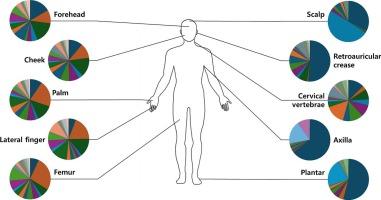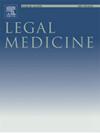韩国10个地点用于法医应用的皮肤微生物组的比较分析:一项试点研究。
IF 1.4
4区 医学
Q3 MEDICINE, LEGAL
引用次数: 0
摘要
多种微生物与人体皮肤细胞存在共生关系,受内在和外在因素的影响。人体微生物组的组成因皮肤部位而异。为了研究韩国人不同皮肤部位的微生物特征,我们从头皮、前额、脸颊、耳后皱褶、颈椎、腋窝、手掌、侧指、股骨和足底皮肤采集了微生物组样本。采用QIIME2和MicrobiomeAnalyst平台进行微生物分析,定量测定人、细菌DNA浓度。额头和脸颊的微生物组成相似,链球菌的比例高于其他部位。手掌和侧指的微生物组成也相似,血友菌的比例高于其他部位。劳索菌主要分布于头皮,支原体主要分布于颈椎。葡萄球菌在所有部位均可见,尤其以腋窝为主。足底微生物组成明显,与其他地点相比,没有流行属。进一步的研究分析来自法医证据的皮肤微生物组可以帮助确定皮肤样本的来源,帮助重建犯罪现场。将韩国参与者的研究结果与国际研究结果进行比较,表明扩大研究范围以包括不同人群可以揭示皮肤微生物组的地区和国家差异,为法医科学提供有价值的见解。本文章由计算机程序翻译,如有差异,请以英文原文为准。

Comparative analysis of skin microbiome across 10 sites in Koreans for forensic applications: a pilot study
Various microorganisms have a symbiotic relationship with human skin cells, influenced by intrinsic and extrinsic factors. The composition of the human microbiome varies based on the skin site. To investigate the microbial characteristics of different skin sites in Koreans, microbiome samples were collected from the scalp, forehead, cheek, retroauricular crease, cervical vertebrae, axilla, palm, lateral finger, femur, and plantar skin. The concentrations of human and bacterial DNA were quantified, and QIIME2 and MicrobiomeAnalyst platforms were used for microbial analysis. Forehead and cheek microbiome compositions were similar, with higher proportions of Streptococcus than that at other sites. Palm and lateral finger microbiome compositions were also similar, with higher proportions of Haemophilus than that at other sites. Lawsonella was specifically observed on the scalp, while Mycoplasma was found on cervical vertebrae. Staphylococcus, observed on all sites, was particularly predominant on axilla. The microbial composition of plantar was distinct, with no prevalent genus compared to that at other sites. Further research analyzing skin microbiomes from forensic evidence could help identify the origin of skin samples, aiding in crime scene reconstruction. Comparing our findings from Korean participants with international studies, it suggests that expanding research to include diverse populations could reveal regional and national differences in skin microbiomes, providing valuable insights for forensic science.
求助全文
通过发布文献求助,成功后即可免费获取论文全文。
去求助
来源期刊

Legal Medicine
Nursing-Issues, Ethics and Legal Aspects
CiteScore
2.80
自引率
6.70%
发文量
119
审稿时长
7.9 weeks
期刊介绍:
Legal Medicine provides an international forum for the publication of original articles, reviews and correspondence on subjects that cover practical and theoretical areas of interest relating to the wide range of legal medicine.
Subjects covered include forensic pathology, toxicology, odontology, anthropology, criminalistics, immunochemistry, hemogenetics and forensic aspects of biological science with emphasis on DNA analysis and molecular biology. Submissions dealing with medicolegal problems such as malpractice, insurance, child abuse or ethics in medical practice are also acceptable.
 求助内容:
求助内容: 应助结果提醒方式:
应助结果提醒方式:


